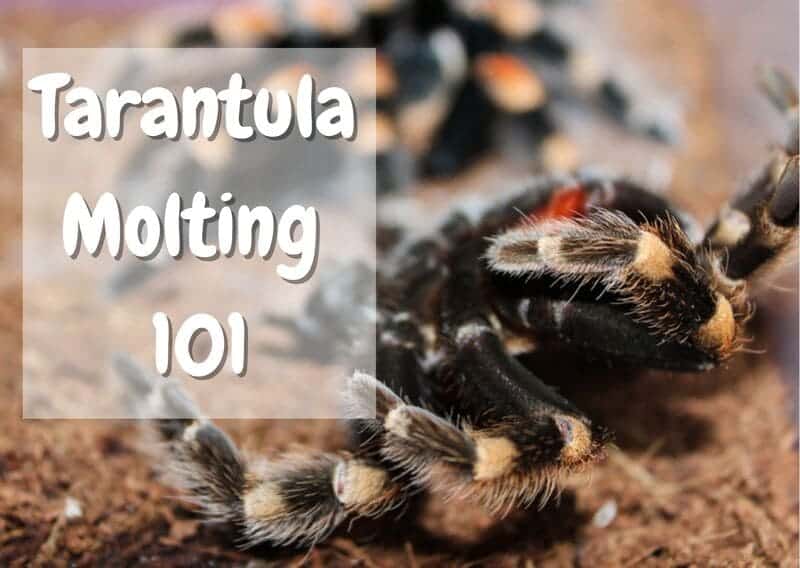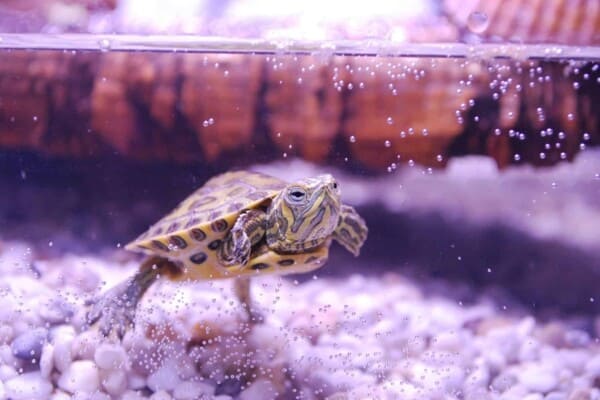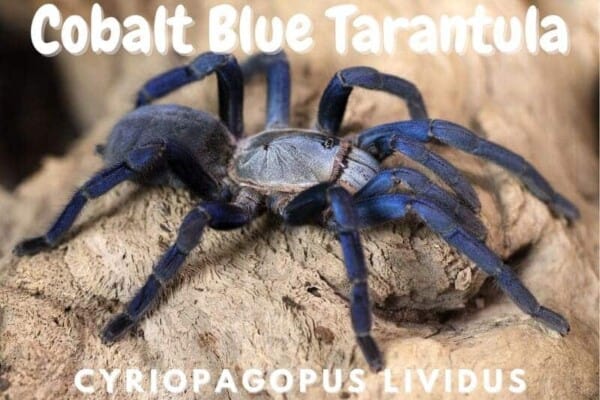When it comes time for your tarantula to molt, it can quickly become rather stressful. When tarantulas molt or prepare to molt, they display a number of symptoms that can be concerning, especially if you do not know what they are symptoms of.
Tarantulas are also extremely vulnerable during this time period, so it is important that you understand how to care for them properly before, during, and after the molting process.
In this article, you will find all of the information that you need to care for your pet tarantula through the molting process. We will go over what tarantula molting is, what to expect throughout the process, how to care for your tarantula, and possible problems you could run into.
What Is Tarantula Molting?
Molting is a process that every single animal with an exoskeleton goes through in addition to some other animals like snakes that shed their skin all at once. This process is very natural, and it is necessary if a tarantula is going to grow at all. Because it is part of the growing process, it happens more often when your tarantula is young.
When animals with exoskeletons grow over time, their outer shells do not grow along with them. Before long, this can make them rather uncomfortable, so they have to shed the old exoskeleton and grow a new (bigger) one.
Getting rid of an exoskeleton and replacing it with a new one is not an easy process. It has to completely shed the current hard shell before it can grow a new one. This often leaves a spider extremely vulnerable for a few days. Additionally, if the spider gets stuck in its molt, it can be dangerous or even fatal.
What Happens When A Tarantula Molts?
When it becomes necessary for a spider to molt or shed its exoskeleton, the body will automatically release hormones that initiate the molting process. When the molting starts, the inner layer of the exoskeleton will start to break down back into nutrients that the tarantula can reabsorb and use later on when it is time to grow the new exoskeleton.
Until the new exoskeleton is ready, the outer layer stays in place to try to keep the spider protected for as long as possible. However, until the molt is complete, the new exoskeleton remains soft, so your tarantula will inevitably be vulnerable.
When the new exoskeleton is ready, the tarantula will shed the old one. It will do this by using air and blood pressure to expand its body and crack the old shell. As the old one is removed, the new one will expand and start to harden. After a few days, when the new exoskeleton is firm, the molting process is considered complete.
Why Do Tarantulas Molt?
So if molting is stressful, leaves your tarantula extremely vulnerable, and can be deadly, why does your tarantula do it? Well, like all creatures, your tarantula needs to grow. Growth will be especially rapid during your tarantula’s first year of life.
However, unlike humans whose skin grows with them, tarantulas’ exoskeleton does not. Because of this, it has to routinely shed the old exoskeleton and replace it with a new one. While molting can be dangerous, not molting is not an option if your tarantula wants to survive.
How Long Does It Take For A Tarantula To Molt?
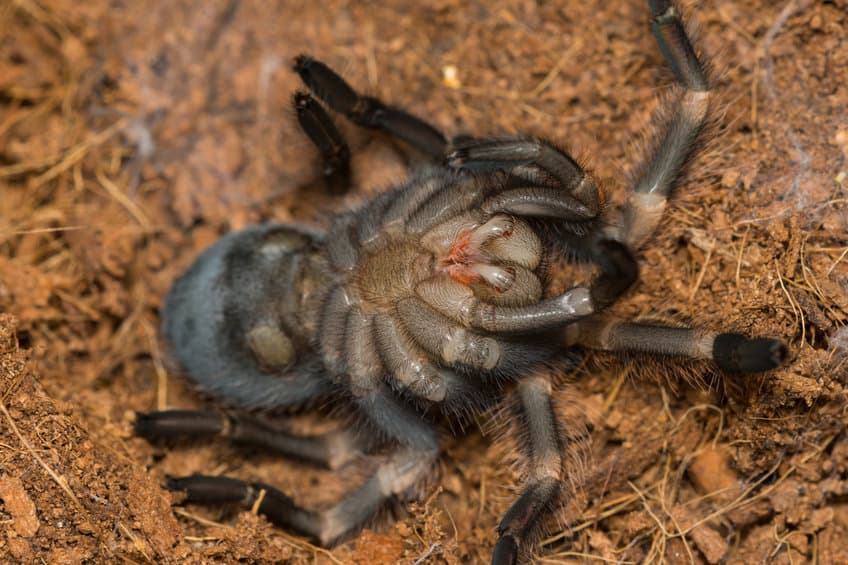
There are a couple of different things to consider when it comes to how long it takes a tarantula to molt. The actual molting process, which is when the tarantula starts to crack the old exoskeleton and replace it with a new, softer, and bigger one, should only take up to a few hours.
Sometimes, it can be a very quick process. Your tarantula might only need 15 minutes to shed an old exoskeleton. On the other hand, it can take several hours for this process to continue. Anything under 24 hours is considered normal and nothing to worry about.
On the other hand, if your tarantula is on its back or attempting to shed its exoskeleton for more than 24 hours, it may be time to start worrying. You might want to reach out to a vet who is specialized in exotic pets to know what to do next.
So altogether, the pre-molt period and post-molt period can last days or even weeks. You might start to notice signs that a molt is approaching several weeks before the actual molt occurs. Additionally, after your tarantula sheds its old exoskeleton, it will take a couple of days for the new one to firm up and offer protection.
How Often Do Tarantulas Molt?
Because tarantulas usually molt due to growth (and lack of exoskeleton growth), the frequency of the molts depends a lot on your tarantula’s age. When your tarantula is young, it will likely molt a lot. Young tarantulas grow rapidly and therefore will outgrow their exoskeleton pretty quickly. Early on in your spider’s life, you can expect that it will likely molt up to once every single month, but it will likely be a quicker process than later on.
The frequency of your tarantula’s molting will decrease significantly as it becomes an adult. Most adult tarantulas only molt about once every year or even every couple of years. Your spider may cease molting entirely as it becomes a senior tarantula.
Of course, the exact amount of times your tarantula will molt depends on the exact species or breed. Some tarantula breeds molt a lot while others rarely do, even when they are young. Besides differences due to the breed, molting frequency should not vary too much between individual tarantulas.
What Are The Signs That My Tarantula Is About To Molt?
- A Decrease In Appetite. When a tarantula starts to get ready to molt, it will start to eat less or even stop eating completely. Often, tarantulas will even go a few weeks without eating in preparation for a molt.
- A Decrease In Activity. When a tarantula is getting ready to molt, you might notice an extreme decrease in activity. If you do not know what you are looking for, it can be alarming when your tarantula starts acting slow and sluggish, but it really is nothing to worry about.
- Development of A Bald Spot. A few weeks before your tarantula molts, you might notice a bald spot develop on its abdomen. This bald spot will often grow darker as it gets closer and closer to molting. As soon as the molt is complete, the bald spot should be gone.
- An Increase In Webbing. Tarantulas do not usually make a lot of webbing because they live in burrows rather than webs. However, tarantulas will make a mat out of silk webbing to lay on during a molt.
- Dull Coloration. Depending on the breed of tarantula you have, it likely has some sort of coloring to its skin/hair. When your tarantula is nearing a molt, these colors will become much duller.
- Laying On Back. By the time your tarantula is actually laying on its back, the molt has likely already begun, and you should leave your spider alone completely.
What Should I Do Before, During, and After My Tarantula Molts?
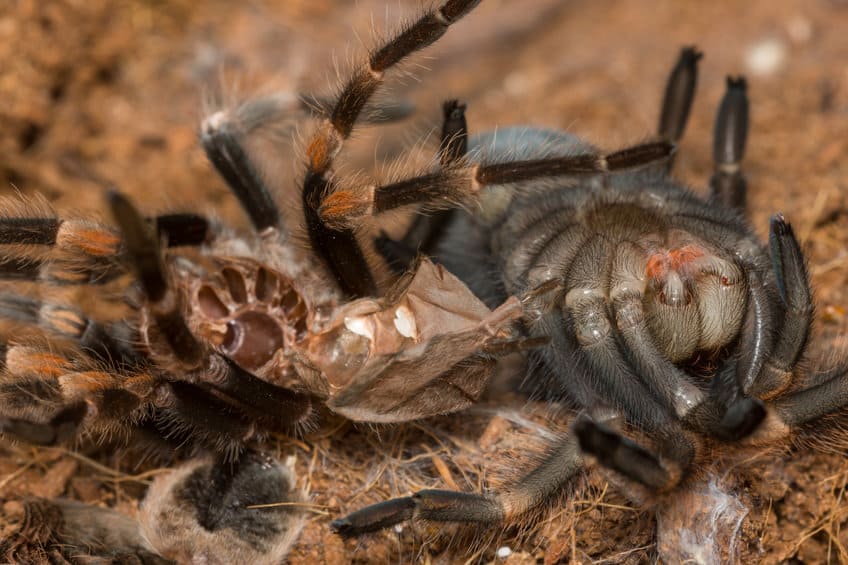
1. Before the molt
Before your tarantula molts, there is not too much that you are going to have to do besides help make sure the enclosure is safe and ready. When your tarantula’s appetite slows down or halts, stop putting crickets or food in the enclosure. When the actual molt occurs, there should not be any live food in the enclosure.
You are also going to want to make sure that your tarantula has plenty of water in the weeks or months leading up to the molt. Lack of hydration is a common reason for a molt to fail. You also want to make sure there is plenty of humidity in the enclosure. Humidity will also help your tarantula successfully molt without problems or injury.
2. During the molt
The most important thing to do during your tarantula’s molt is to leave your tarantula completely alone. Your tarantula is extremely vulnerable and prone to stress when going through the molting process. Disturbing him at all could lead to serious injury or even death.
Stop touching, picking up, or messing with your tarantula when it starts to show signs of molting and until at least a week has passed after the molt is complete. You also do not want to clean out or change its enclosure during a molt. You should not mist your tarantula while it is molting either – simply make sure there is enough water in the water dish for added internal hydration.
3. After the molt
Your tarantula will be able to do most of the molting process on its own, so there is not a lot that you have to do at any stage, including after. Once your tarantula is done molting, you are going to want to remove the exoskeleton at some point.
Make sure that you wait until your tarantula moves the old exoskeleton somewhere that it is easily accessible. Using tweezers or a small pair of tongs can be helpful.
When it has been five days to a week, you can go ahead and feed your tarantula. It will likely be very hungry. However, it should have been drinking the whole time and should have already had access to fresh drinking water throughout the whole process.
What Happens If You Disturb A Molting Tarantula?
So we have made it clear that your tarantula needs to be left alone when molting, but what happens if you disturb him? Well, there are a couple of different possibilities. The best-case scenario is that you are gentle enough that it does not cause any major problems.
On the other hand, it could cause your tarantula a lot of stress. Stress could cause your tarantula to fail to complete the molt. This failure could cause an injury, and it will likely be deadly.
Finally, if you disturb a molting tarantula, you could injure him. When tarantulas do not have a hardened exoskeleton, they are extremely vulnerable and really easy to injure. A gentle touch or simply picking him up can cause major problems.
How Dangerous Is The Molting Process For The Spider?
When you see the signs of your tarantula molting, it can look very alarming. Many of the signs listed in the next section can make it seem like your tarantula is dying rather than actually molting. But is the process actually dangerous, or does it just look like it is when you do not know what is happening?
Most of the time, tarantulas are able to molt without any major complications. However, it is a very vulnerable and stressful time for your tarantula. If it is touched or disturbed during the actual molting, it could lead to serious injury or even death.
Additionally, if the molt fails, it can be fatal. A failed molt is when your tarantula gets stuck in the molt. This usually happens due to a lack of hydration or moisture in the enclosure. Your tarantula feeling overly stressed can also lead to a failed molt.
How Do I Know That My Tarantula Is Having Difficulty Molting?
There are a couple of different signs that your tarantula is having difficulty molting. One of the most obvious is if your tarantula keeps moving into position to molt but not actually molting. It may stay in that position for a few minutes or a few hours before getting up without actually molting. It might even look like it is practicing a molt, but tarantulas do not naturally practice, so it is actually a sign you should be worried about.
Another potential sign of a problem is it taking too long to complete a molt. A molt can take anywhere from 15 minutes to take several hours to complete, so slight variations in time do not have to be all that worrisome. However, once you notice your tarantula has been molting for 24 hours or more, it might be time to feel some concern.
If it is just a deformed leg or piece that your tarantula cannot seem to successfully molt, you might be able to use a pair of tweezers to gently help the process along. However, this should only be used if absolutely necessary because it could cause more problems or injure your tarantula. For any bigger problems, you should reach out to your vet rather than attempting to handle the situation yourself.
What Should I Do With The Molt Afterward?
What you should do with your tarantula’s molt depends on how easy it is to access. If it is easy to get to it after your tarantula is done molting, you can go ahead and remove it. Make sure the tarantula has had plenty of time to harden again before trying to remove it.
On the other hand, if it is not easy for you to pick up and remove the molt with a pair of tongs, you should just leave it in the enclosure. Never destroy a burrow or pull-down webbing to try and remove it because leaving the molt in the enclosure will not harm your tarantula in any way. Tarantulas generally like to keep their homes neat, so before long, it will likely be moved to a trash pile or placed in the water dish, where it will be much easier to remove.
After your tarantula has completed a molt, it may appear like your tarantula is eating the exoskeleton or the old exuvia. However, this is not what is actually happening. He is actually attempting to eat or recover some of the moisture that is lining the exoskeleton. This can sometimes lead to the molt looking chewed or shredded, which will prevent you from using it to figure out the sex.
How Long After Molting Can I Feed My Tarantula?
Your tarantula does not eat in preparation for a molt. When it is young, it may only stop eating for a few days or weeks prior to a molt. However, when it gets older or in preparation for a big molt, it might stop eating for months before the actual molt.
This means that when the molt is finally complete, it will be hungry and ready to eat. However, if you put live food in the enclosure before the new exoskeleton has firmed up, even small things like crickets could injure your tarantula.
Some people only wait a few days after a molt is complete to feed their tarantula. On the other hand, many people wait at least a week before putting any prey (like crickets) into the enclosure to make sure the tarantula is completely protected and not so stressed. No matter how long you wait, it is best to start small with just one cricket.
Related articles:
Resources and further reading:
- Tarantula Growth and development, cec.org
- The Molting Sequence in Aphonopelma chalcodes (Araneae: Theraposidae), Edwin W. Minch
Contents
- What Is Tarantula Molting?
- How Long Does It Take For A Tarantula To Molt?
- How Often Do Tarantulas Molt?
- What Are The Signs That My Tarantula Is About To Molt?
- What Should I Do Before, During, and After My Tarantula Molts?
- What Happens If You Disturb A Molting Tarantula?
- How Do I Know That My Tarantula Is Having Difficulty Molting?
- What Should I Do With The Molt Afterward?
- How Long After Molting Can I Feed My Tarantula?

